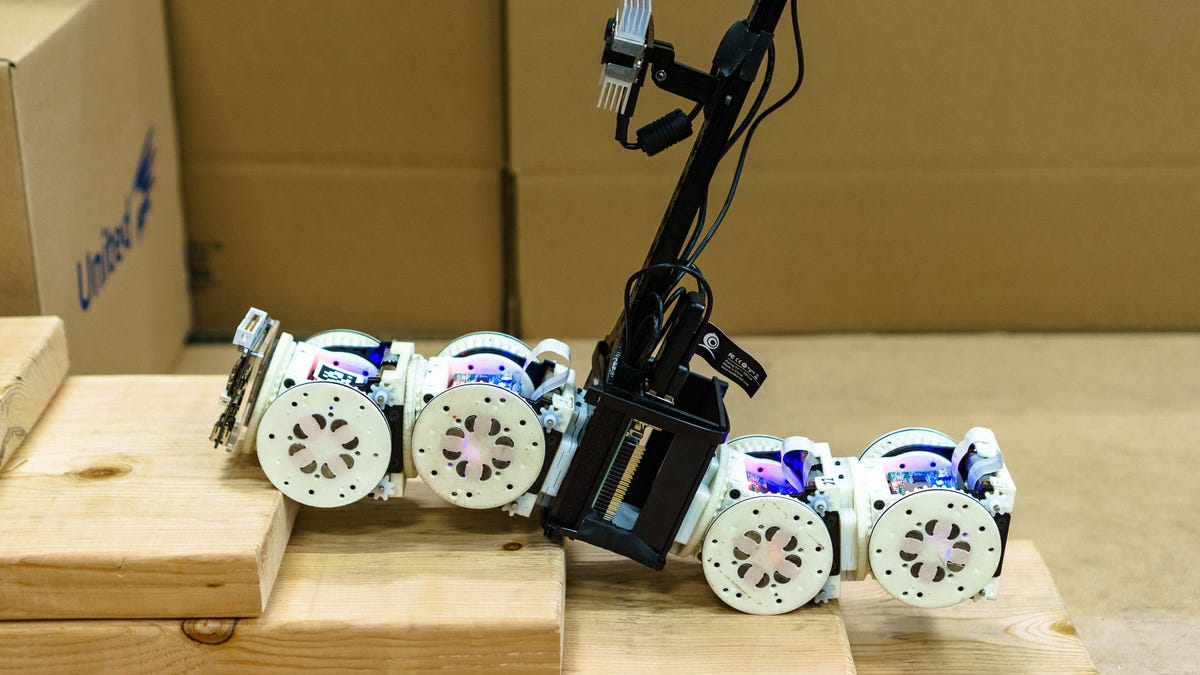Transformers-like robot shifts shape at will to tackle challenges
This robot scopes out its environment and autonomously decides what it needs to do to get the job done.
A little wheeled robot rolls up to the base of the stairs and dismembers a couple of its body parts before starting the climb. To get up the steps, the bot needs to be narrower, and losing its mechanical "shoulders" does the trick.
Notable here is that the bot scanned and assessed its unfamiliar surroundings, and, on its own, shifted shape to accomplish the task at hand -- climbing a set of five stairs to drop a circuit board into a cardboard box.
"I don't actually prescribe, 'Move to the left, change your shape,'" said Hadas Kress-Gazit, associate professor of mechanical and aerospace engineering at Cornell University and principal investigator on new research featuring the bot. "All these decisions are made autonomously by the robot."
This modular self-reconfigurable robot (MSSR) brings the vision of adaptive, multipurpose modular robots a step closer to reality, its creators say. Autonomous MSSRs could prove especially useful when maneuvering unfamiliar, changing terrain to do things like clean up from an earthquake or other natural disaster in which robots might need to enter cracks and crevices.
"This is the first time modular robots have been demonstrated with autonomous reconfiguration and behavior that is perception-driven," Kress-Gazit said. Her team's research is detailed in the latest issue of Science Robotics.
Modular robots have interchangeable parts that can be removed and replaced, making them configurable and more flexible than robots with fixed components.
The bots used here are made up of wheeled, cube-shaped modules, developed at the University of Pennsylvania, that can detach and reattach to form new shapes with varying capabilities.
The cubes attach to one another with magnets and connect to a sensor module equipped with multiple cameras and a small computer for collecting and processing data about the robot's surroundings. Each module has an onboard battery, microcontroller and Wi-Fi chip for communicating with a centralized system.
The robot chooses its shape based on a software library of 57 possible configurations set to match specific tasks. It can transform itself into something resembling a snake, for example, or sprout a long arm in front.
"The system automatically selects appropriate behaviors to meet the requirements of the task and constraints of the perceived environment," the research paper reads. "Whenever the task and environment require a particular capability, the robot autonomously self-reconfigures to a configuration that has that capability."
The robot successfully demonstrated its decision-making skills and autonomy in three experiments, though the one with the steps took 24 tries.
As the old saying goes, robots that don't need your help, thank you very much, weren't built in a day.
The robot has interchangeable modules that attach to one another with magnets.
Taking It to Extremes: Mix insane situations with everyday tech. Here's what happens.
Batteries Not Included: The CNET team reminds us why tech is cool.


